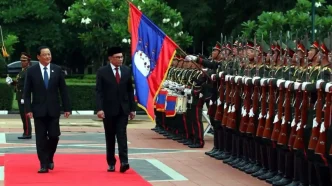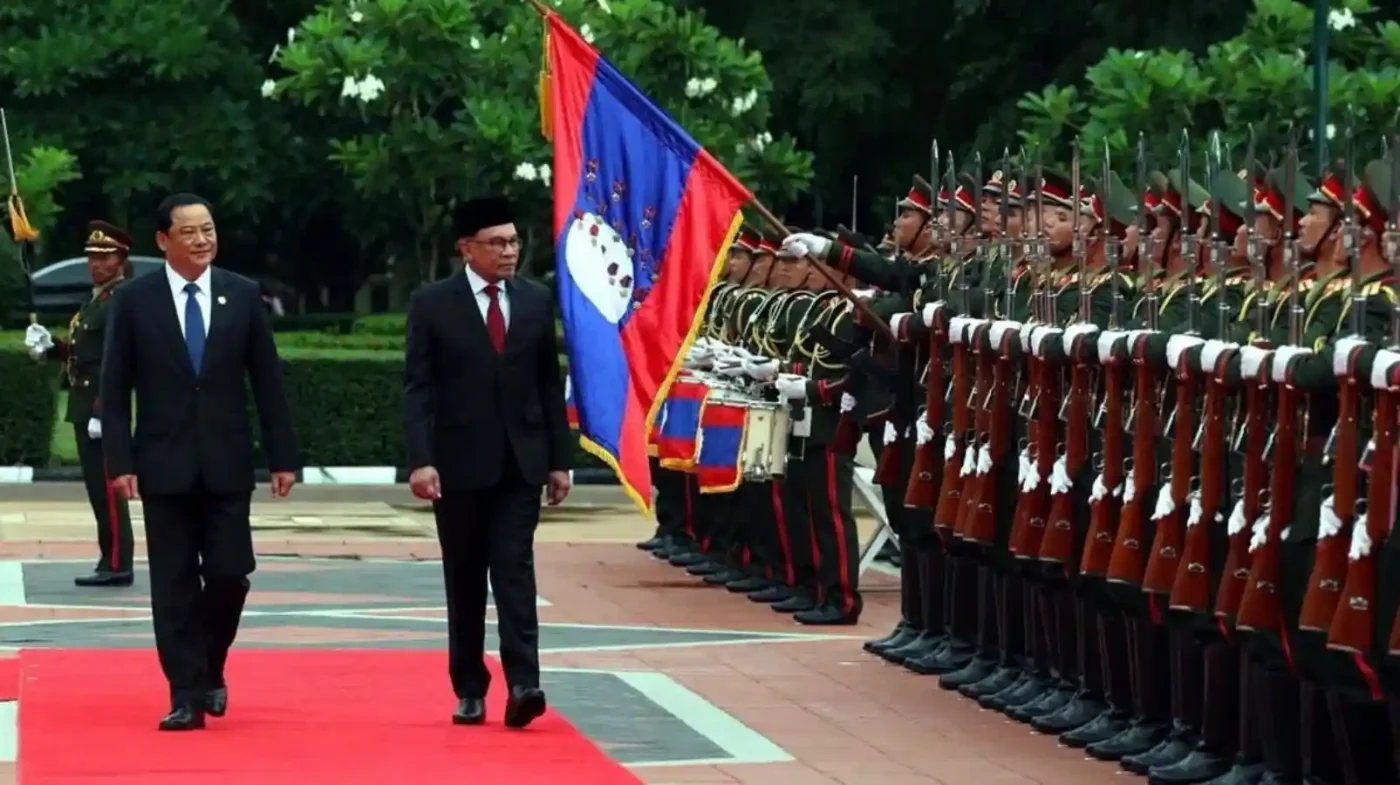In a bid to bolster economic collaboration, Lao Prime Minister Sonexay Siphandone delivered a compelling keynote address at the High-Level Laos-Malaysia Business Forum in Kuala Lumpur, urging Malaysian businesses to seize investment opportunities in Laos. Highlighting strategic advantages and recent reforms, the Prime Minister painted a picture of a nation on the cusp of transformation, eager to deepen ties with one of its key regional partners during his visit for the 46th ASEAN Summit.
A Call for Investment
Addressing over 180 participants, including government officials, ambassadors, and business leaders from sectors such as energy, trade, agriculture, banking, tourism, and logistics, Prime Minister Sonexay emphasized Laos’ potential as a destination for foreign investment. “Many sectors of the Lao economy have potential for foreign investment, including Malaysian financiers” he said during the forum, which was jointly organized by the Lao National Chamber of Commerce and Industry, the Malaysian Business Council in Laos, and the Federation of Malaysian Manufacturers, with support from both countries’ ministries and Mega First Corporation.
Malaysia currently stands as Laos’ fourth-largest foreign investor, with investments totaling US$946 million across 88 projects. These span critical areas such as renewable energy, transport, telecommunications, construction, banking, and hospitality. The Prime Minister urged Malaysian companies to explore further opportunities in agriculture, green energy, food processing, mining, logistics, digital tourism, and emerging carbon credit markets, positioning Laos as a frontier for innovative and sustainable investments.
Strategic Advantages and Infrastructure Growth
A key pillar of Laos’ appeal, as outlined by Prime Minister Sonexay, is its growing role as a regional transportation hub. The Laos-China Railway, upgraded road networks, new expressways, dry ports, and the recent launch of berth 3 at Vung Ang Port in Vietnam have significantly enhanced connectivity and reduced transport costs. “We have expanded connectivity with neighboring countries by establishing ourselves as a regional transportation hub” he said, underscoring how these developments position Laos as a vital link in Southeast Asian trade corridors.
A notable highlight from the forum was the signing of a Memorandum of Cooperation between Thanaleng Dry Port in Laos and Malaysia’s Penang Port. This agreement aims to create a strategic trade corridor connecting southern China to Malaysia’s west coast via Laos and Thailand, further cementing logistical ties between the two nations. Such initiatives are poised to amplify trade, which already saw a significant increase in 2024, reaching over US$43 million, up from US$30 million in 2023, according to data from the Lao Ministry of Foreign Affairs.
Reforms to Woo Investors
Prime Minister Sonexay also detailed recent government efforts to improve the business environment in Laos, signaling a commitment to fostering foreign investment. Among these reforms is the revision of the Investment Promotion Law in 2024, alongside streamlined administrative procedures and the introduction of digital platforms for business registration and tax services. Additionally, mechanisms like the Lao Business Forum have been established to facilitate ongoing dialogue between the public and private sectors, ensuring that investor concerns are addressed promptly.
The Prime Minister pointed to Laos’ 21 special economic zones, including the Amata and Sino-Agri Potash SEZs, as prime locations for industrial and manufacturing investments. These zones offer incentives and infrastructure tailored to attract foreign capital, particularly in sectors where Malaysian expertise in energy, infrastructure, and financial services could play a transformative role. “This forum marks an important step forward in building lasting partnerships. I invite Malaysian businesses to visit Laos, explore our investment opportunities and grow with us” he said, extending a direct invitation to deepen bilateral engagement.
Economic Context and Regional Dynamics
The Laos-Malaysia Business Forum comes at a pivotal moment for Laos, a landlocked nation striving to transition from a least-developed country status to a more integrated regional economy. With a population of approximately 7.5 million and a GDP heavily reliant on agriculture, hydropower, and mining, foreign investment is critical to diversifying its economic base. Malaysia, with its established industrial and financial sectors, represents a valuable partner in this journey, offering both capital and technical know-how.
The forum also aligns with broader ASEAN objectives, as leaders from across the region gathered for the 46th ASEAN Summit in Kuala Lumpur. Economic integration remains a cornerstone of ASEAN’s agenda, and bilateral engagements like this forum serve as building blocks for the ASEAN Economic Community’s vision of a single market and production base. For Laos, strengthening ties with Malaysia could provide a gateway to broader regional markets, while for Malaysia, investing in Laos offers access to a strategically located economy with untapped potential.
Challenges and Opportunities Ahead
Despite the optimism expressed at the forum, challenges remain for foreign investors in Laos. Bureaucratic hurdles, while being addressed through reforms, can still pose delays, and the country’s infrastructure, though improving, requires sustained investment to meet international standards. Additionally, Laos’ reliance on hydropower and mining has raised environmental concerns among some regional observers, who caution that unchecked development could impact local communities and ecosystems. If green energy and sustainable practices are prioritized, as suggested by Prime Minister Sonexay, partnerships with Malaysian firms could help mitigate these risks.
Analysts note that Malaysia’s expertise in renewable energy—particularly in solar and hydroelectric projects—could align well with Laos’ ambitions to expand its green energy sector. Similarly, Malaysian companies with experience in digital platforms and logistics could play a role in modernizing Laos’ tourism and transport industries, sectors identified as high-potential areas during the forum. However, the success of these ventures will depend on how effectively the Lao government can translate policy reforms into tangible outcomes for investors.
Bilateral Trade on the Rise
The upward trajectory of trade between Laos and Malaysia reflects growing mutual interest. The jump from US$30 million in 2023 to over US$43 million in 2024 signals a strengthening economic bond, though the figures remain modest compared to Malaysia’s trade with larger ASEAN economies like Thailand or Indonesia. For Laos, however, every increment in trade and investment represents a step toward economic resilience, particularly as it seeks to reduce dependence on traditional sectors and neighboring giants like China and Thailand.
The diversity of Malaysian investments in Laos—from banking to hospitality—demonstrates the breadth of opportunities available. This diversified portfolio not only mitigates risk for investors but also ensures that economic benefits are spread across multiple sectors of the Lao economy. As the government continues to promote special economic zones and connectivity projects, the stage is set for Malaysian businesses to play a larger role in shaping Laos’ economic future.
Looking Forward
As Laos and Malaysia chart a path toward deeper economic collaboration, the outcomes of the Kuala Lumpur Business Forum could serve as a catalyst for transformative partnerships. With Laos positioning itself as a regional hub and Malaysia seeking new frontiers for investment, the synergy between the two nations holds promise for mutual growth. Yet, the true test will lie in implementation—whether Laos can sustain its reform momentum and whether Malaysian businesses will take up the Prime Minister’s invitation to explore and invest. For now, the forum stands as a testament to the power of dialogue in forging economic ties that could reshape the region’s landscape.
















